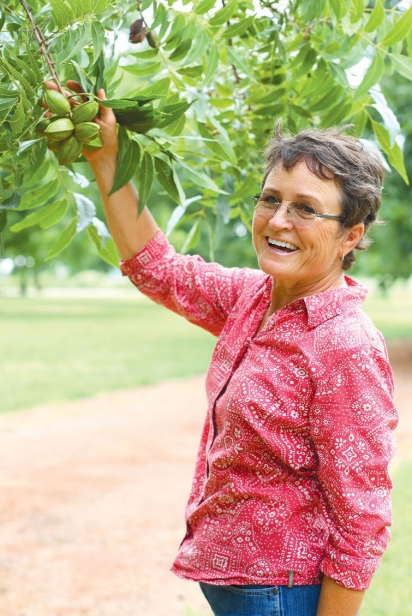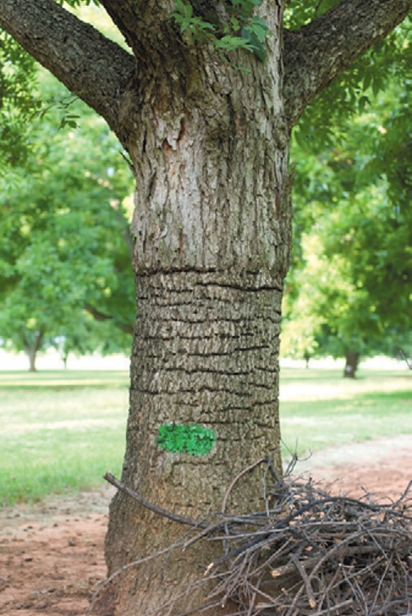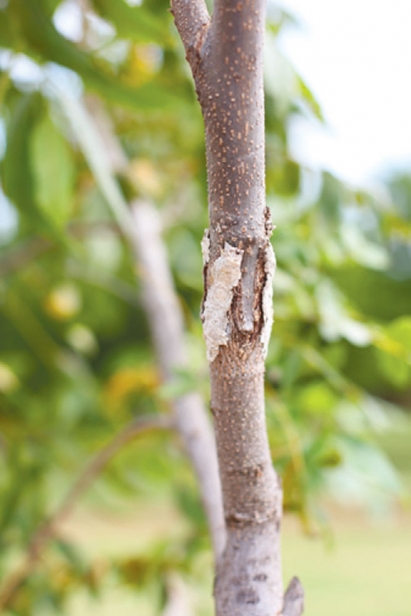True Natives
Oklahoma Pecans from Couch Orchard
Diane Couch says: “Why do you prefer a Fuji over a Red Delicious?” She is talking about apples, but we are speaking of pecans. Like most people, I thought a pecan was a pecan. I was wrong.
This magazine is about local food. It is about how we cook it, how we eat it, and how we relate to it. If you had to pick out a food for Oklahoma that is the “most local,” a pecan would be a good candidate. Pecan trees are native to North America, and to Oklahoma. People have been eating pecans in Oklahoma since pre-Columbian times. Pecans were an important staple food for Native Americans in the fall.
Diane Couch runs Couch Orchard in Luther, OK. The original orchard sits on a lovely triangle of land between Route 66, Luther Road, and the Deep Fork River. Diane’s father Gordon started the original orchard in the early 1960s. Diane planted another orchard about two miles away twenty years ago. Between the two, they have about 700 trees. At Couch Orchard, they grow pecans and sell them beginning November 15 every year. Diane refers to November 15 as “Opening Day.”
The pecan tree (Carya illinoinensis) is a species of the genus Hickory (Carya). A pecan is not really a nut, but is actually a drupe (a fruit with a single pit surrounded by a husk.) Other drupes are peaches, apricots, cherries, olives, coffee, almonds, and coconuts. Blackberries and raspberries are made up of little drupelets. One could eat only drupes and eat quite well.
At Couch Orchard, they grow thirteen varieties of pecans. The question I asked Diane which prompted her response about apples had to do with the difference between varieties of pecans. Some varieties are sweeter, or oilier, or bigger, or firmer than others. Some popular varieties Couch Orchard grows are Pawnee, Kanza, Meramec, and Mohawk.
You may have noticed that some of the pecan varieties are named after Indian tribes. The United States Department of Agriculture (USDA) breeds pecans; these are typically papershell hybrids, and are usually named after Indian tribes. Other varieties are propagated from native trees. For example, the popular Maramec was cultivated from a tree growing in Emma Charlton’s yard in Maramec, Oklahoma in the 1960s.
Diane informs me that she can’t just plant a pecan from a Maramec tree and expect another Maramec tree to grow. She says you never know what you will get with pecans. For this reason, Diane and other pecan growers use the technique of grafting to clone a desired variety.
Grafting is simply cutting a small branch from a tree you want to duplicate and attaching it firmly to another tree (the root-stock.) A popular method for grating is the “four-flap” method. This technique was popularized in Oklahoma in the 1970s.
At Couch Orchard, many of the current trees consist of different varieties grafted (via the four-flap method) on to Stuart root-stock. Stuart is an older variety that does well as a root-stock. A vivid example of the inherent strangeness of grafting and cloning are the holes drilled in the Stuart parts of the trees by the Yellow Bellied Sapsucker. That is a type of woodpecker which drills holes in trees to get the sap. For some reason, those birds only like Stuart sap. The result is that you can see the bands of the tree where the Stuart root-stock stops and starts (it is the only part of the tree with holes).
Being native to Oklahoma, pecan trees prosper here in weather that would kill other types of trees. Pecan trees love a hot and humid summer, but also need a freeze to help the nuts fall out of the trees.
Diane does not have the luxury of pre-planned freezes, so she uses a tree-shaker in August to shake off and thin out some of the pecans. This makes the remaining nuts bigger, tastier, and more likely to split open at the right time so they can get ready to fall. Diane then shakes the trees again at harvest time to get the pecans to fall instead of waiting for a freeze that may come too late. Her main enemy is the crow. She has cannons in the orchard that shoot blanks to scare off the birds.
Because no two native pecan trees are the same, it was not until the rise of grafting and cultivation in the mid-to-late 1800s that pecan growing really took off in the United States. While pecans are uniquely American—the United States grows in excess of 80% of the world’s supply—they are becoming very popular in China and other Asian countries.
Speaking of popularity, at Couch Orchard, Opening Day is a spectacle. Diane says people line up early in the morning on November 15 to get a number so they can buy pecans. Couch sells pecans from Opening Day until they run out. Typically that is around the first of the year.








